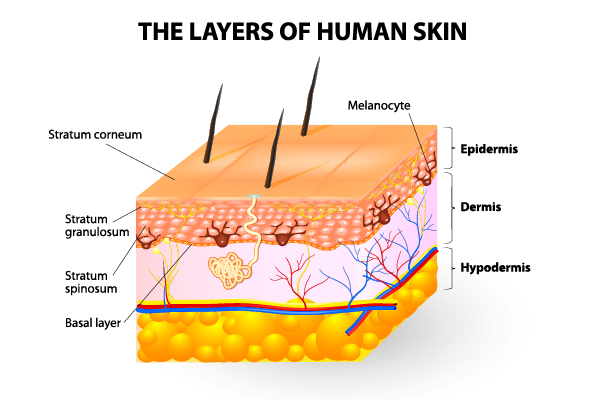Origin: a Latin derivative
meaning "Gift of the Earth."
Part 5: The Appropriate Dose (Topical Application)-Anatomy of the Skin

Understanding the composition and structure of the skin is an important part of appropriately applying essential oils. To the left is a diagram of the skin’s anatomy.
The outermost layer of skin is called the epidermis; however, this layer is made up of several sub-layers:
Stratum Basale. This is the deepest layer of the epidermis, where keratinocyte (the primary skin cells) are constantly growing and dividing. Creation of new skin cells is a continuous process because the skin is constantly being shed. On average, humans lose between 30,000–40,000 skin cells every single hour! The entire skin is completely replaced approximately every 40 days. This layer also contains melanocytes, which are specialized cells that produce melanin, the pigment that gives the skin color.
Stratum Spinosum. In this layer, keratinocytes continue to divide, but at a much slower pace than in the Stratum Basale. Keratinocytes begin to produce keratin, the fibrous structural protein that gives skin its strength.
Stratum Granulosum. Upon migrating into this layer, keratinocytes are cut off the nutrient supply and begin to die. As a result, the cells lose their nuclei, flatten out, and begin to fill up with the tough, fibrous keratin protein. Water-proofing lipids also begin to be produced.
Stratum Corneum. The outer most layer of skin is called the stratum corneum, which is actually composed of only dead skin cells! This layer protects underlying tissues from damage. You have probably noticed that some areas of your body, for instance, the palm of your hands or the heels of your feet, naturally have thicker skin. These areas actually have a thicker stratum corneum because they are constantly being used and need extra protection. Below the epidermis is the dermis, a layer of connective tissue containing collagen and elastin proteins that give the skin flexibility, elasticity, and strength. As we age, these proteins break down, causing the skin to sag or wrinkle. Also located in the dermis are sensory receptor nerves, blood vessels, hair follicles, lymph vessels, and sweat glands.
Even further down lies the hypodermis (subcutaneous layer), or the deepest layer of skin. This layer is composed of a network of collagen units and fat tissue that help to insulate the body and protect it from temperature changes and blunt injury.





